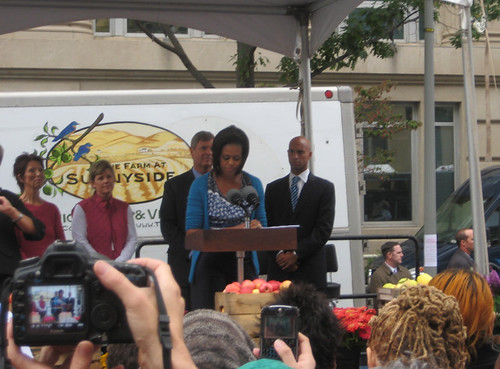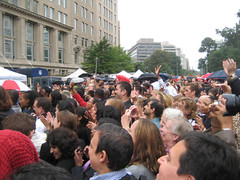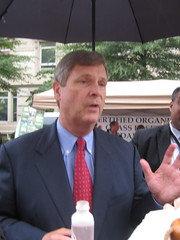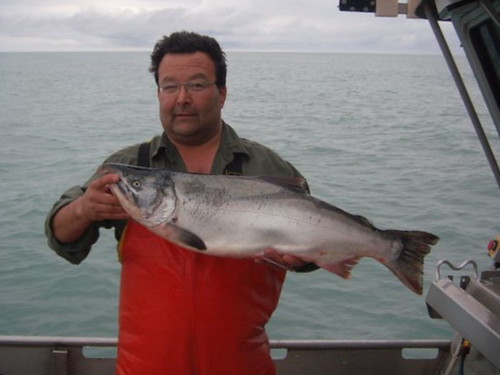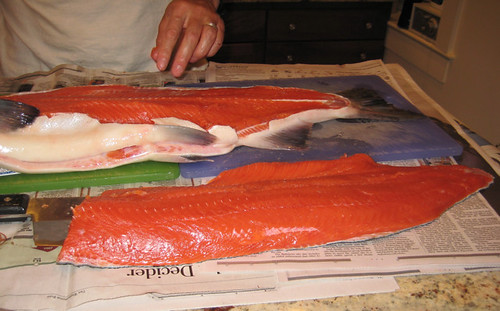
Image source: Bluefin Tuna, Monterey Bay Aquarium
By Samuel Fromartz
Chef Nobu Matsuhisa is one of the world's most celebrated Japanese sushi chefs, and with partners, like Robert De Niro, he operates 24 restaurants globally that have been a favored haunt of Hollywood stars.
But for several years now, he has come under fire for serving bluefin tuna, a spectacular and expensive species of tuna which is dangerously overfished in the Atlantic and Mediterranean. Bluefin tuna populations are one-tenth of what they once were and industrial fishing, a good deal of it illegal, continues to decimate them.
British environmental journalist Charles Clover has been one of Nobu's loudest critics, and in The End of The Line, a powerful new documentary based on his book, bluefin tuna and Nobu's menu are a central issue. (The documentary opens on Monday, World Oceans Day.)
In response, Nobu recently added an asterisk describing bluefin as "environmentally challenged" on the menu and putting the onus on diners to eat it or not. This move has not placated critics, like Greenpeace, which has demonstrated inside Nobu's flagship restaurant. Now the celebs who put Nobu on the map have threatened to boycott the restaurant over the issue. Among them: Charlize Theron, Sting and Elle Macpherson. They want a response by Monday.
Given the potential damage to the chef and his restaurant's reputation, I posed the following question to a number of people, including New York Times columnist Mark Bittman, ocean conservationist and writer Carl Safina, and several others, many of whom work on sustainable seafood issues.
What should Nobu do to resolve his conflict over serving bluefin tuna? How can he both protect his brand and ensure the highest dining experience for his patrons?
Michael Sutton
Director, Center for the Future of the Oceans
Monterey Bay Aquarium
As perhaps the nation's most prominent sushi chef and restaurant owner, Nobu has a vested interest in the sustainability of our seafood supplies. Kuro maguro, or bluefin tuna, is one of the most valuable and prized species for the sashimi market. Nobu naturally wants to supply his patrons with the very best sashimi, so it's understandable that he does not want to remove bluefin tuna from his menus.
But the mark of a real leader is foresight, the ability to consider the future impact of present-day decisions. And it doesn't take much foresight to see that bluefin tuna is seriously depleted throughout its range and could become commercially extinct in the near future. Nobu therefore has a terrific opportunity to become recognized as the savior of the bluefin tuna rather than a principal factor in its demise.
If I were Nobu, I would seize the opportunity and issue a press release saying that after considering the long-term interests of sashimi lovers everywhere, I will no longer serve bluefin tuna in my restaurants until fishery managers have taken appropriate action to put the species on the road to recovery. A decade ago, leading chefs did just that by joining forces with the Give Swordfish a Break campaign, which helped build the political will for swordfish recovery. Many of those leading chefs won praise from their clientele and have now have put swordfish back on their menus, secure in the knowledge that we'll all be able to enjoy swordfish for the future. Nobu, it's your turn to step up to the plate and into the limelight!
---
Mark Bittman
“Minimalist” Columnist,
The New York Times
Author of Food Matters: A Guide To Conscious Eating and other books
Nobu is both a “he” and an “it.” I don’t know if “he” or the organization makes these decisions. It’s very simple. He/it either cares about this issue or does not. From a culinary perspective, I agree that yellowfin tuna is not a real substitute. But there is a world of food out there, and good chefs can work around hardships like this. If enough do, maybe bluefin will come back as a commercially viable species. If not – in short order, no one will be eating it, not even Nobu’s customers. Surely this is understandable.
---
Carl Safina
Author, Song for the Blue Ocean and other books
Founder Blue Ocean Institute
Nobu should do what we should always do: the right thing. The "highest" experience includes the awareness, sense of responsibility, and often the self-sacrifice that goes with real leadership. He should wear the intentional omission of bluefin as a badge of honor.
The fish is doing extremely poorly specifically because of overfishing for sushi markets, and is listed "critically endangered" in the Atlantic. At the extreme minimum, he should stop selling wild bluefin and wait until the Australians (or whoever gets to market first) have farm-hatched fish for sale (not wild-caught, captive fattened). Even that has problems, but no one should be involved in killing wild bluefins at this point.
As far as I'm concerned, a person who does not care enough to do the right thing simply isn't a leader. Catching bluefin tuna and mako sharks was the most thrilling thing I ever did, and I did quite a bit of it--years ago; not anymore. For one thing, they're so rare it's just sad now. For another thing, I don't want to be part of what's obviously a big problem.
As for the "highest" experience, I'll say this: I would not go to Nobu for a free meal. He's just in it for himself and isn't trying to be part of the solution. That's typical, not "highest." There are, as they say, bigger fish to fry. Except that in this case, they're smaller fish, and they're raw.
---
Michael Ruhlman
Author of Ratio, The Reach of a Chef, and other books
While I cynically wonder if Charles Clover is using the tactic of singling out a high profile chef to promote the film based on his book, I also think Nobu ought to respond. He can say I'm doing nothing illegal and my allegiance is to my customer, not the fish. Fair enough.
But I believe it is a chef's duty to care for the earth and the source of his or her food. He ignores it at his own peril. If I were Nobu, I would not serve it and urge others not to. His example would be powerful. Also he's a chef, he should be able to make great food out of my lawn. Why does he need any one single fish to keep his business afloat? Surely he can use his wits and talent to create extraordinary food without relying on the diminishing supply of wild bluefin.
I hear Chilean sea bass is nearly off the endangered list. I'd be willing to go five years or more without bluefin to ensure that it thrived.
---
Fedele Bauccio
Founder and CEO
Bon Appetit Management Co., a premium food service company focused on ethical sourcing for more than 20 years.
I don't see why Nobu has to serve bluefin tuna to protect his brand. The measure of a good chef should be making great tasting food using ingredients that are grown or harvested in a way that protects the well being of guests, the communities where the food is served and the natural environment that provides culinary bounty. Local, seasonal ingredients have been an honored tradition in Japanese cuisine for thousands of years. Why not build the menu around these treasured elements rather than serving a threatened species?
----
Barton Seaver
Founding Chef, Hook, Washington DC
Current Chef, Blue Ridge, Washington DC
The
business of a restaurant is to satisfy guests and even the greatest can
be broken by a fickle clientele. So it's not hard to understand why a
restaurant group such as Nobu continues to play cards that work.
Bluefin tuna is simply the best tuna in the sea. It also takes a lot of
the guess work and variability out of a vast multinational operation.
But
bluefin has not always been the king of the menu. Chefs like Nobu had
to convince guests to try it. "And you want me to eat that raw?" was
most likely the initial response. If chefs like Nobu could vault
bluefin to its star status, then certainly they can use their talent to
introduce guests to a substitute. Kate Winslet has said Nobu's 'food is
like sex on a plate'. That is pretty good praise. Nobu clearly has the
talent and credibility to shape tastes globally. It is time for him to
do so with a delicious and sustainable solution.
---
Mark Powell
Marine Biologist, formerly with Ocean Conservancy
Nobu
should use his standing to help build change. For example, he could
work with bluefin tuna conservationists to create an action campaign,
and he could speak out for conservation and enlist his customers in the
effort. Nobu’s Save the Bluefin campaign could have “action of the
month” opportunities such as advocating for specific management
measures, e.g. science-based catch limits and protected areas for
spawning fish. These could be chosen to address the biggest issues and
opportunities as they arise. There’s a great need to work with people’s
love for fish as seafood, rather than denying and fighting against such
connections. Walking away from bluefin would be the easy way out. Working to correct the problem after years of profiting off the fish would be far more noble.
---
Kozo Ishii
Director, Marine Stewardship Council - Japan Program
There is a growing market for sustainably caught fish that is being supported by fisheries, fish processors, retailers and restaurants in the world. It remains the responsibility for all of us to support these efforts by recognizing and rewarding sustainable fishing where it is occurring. As a celebrity chef and restaurateur, I think that Nobu is in a unique position to further accelerate the supply and demand for sustainably caught fish by not only committing to sourcing it himself, but also by using his voice to help drive home the urgent need to secure fish stocks for future generations.
---
Tim Fitzgerald
Marine Scientist, Oceans Program
Environmental Defense Fund
I'm of two minds on this one. On one hand, it seems clear that the only way forward is to remove it from their menu entirely. And if they really wanted to start repairing their tarnished eco-image, they could even go so far as to call on global tuna fisheries authorities to institute more sustainable management for these species. Or, they could support research to develop eco-friendly aquaculture that does not rely on wild-caught bluefin.
However, consumers have notoriously short memories, and Nobu might decide to weather the PR storm until it blows over. Remember the PCB scare with farmed salmon a few years ago? Six months later the industry was posting record profits as if nothing had ever happened.


